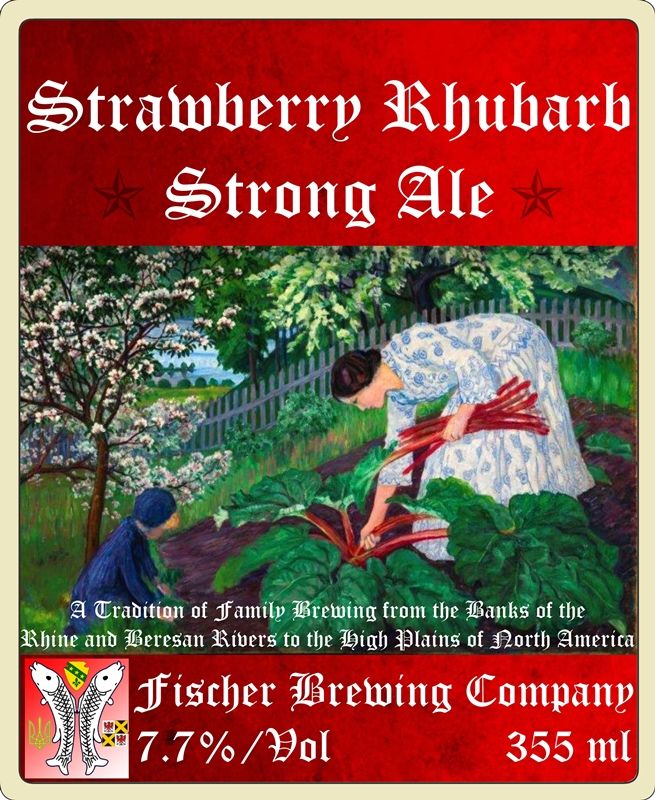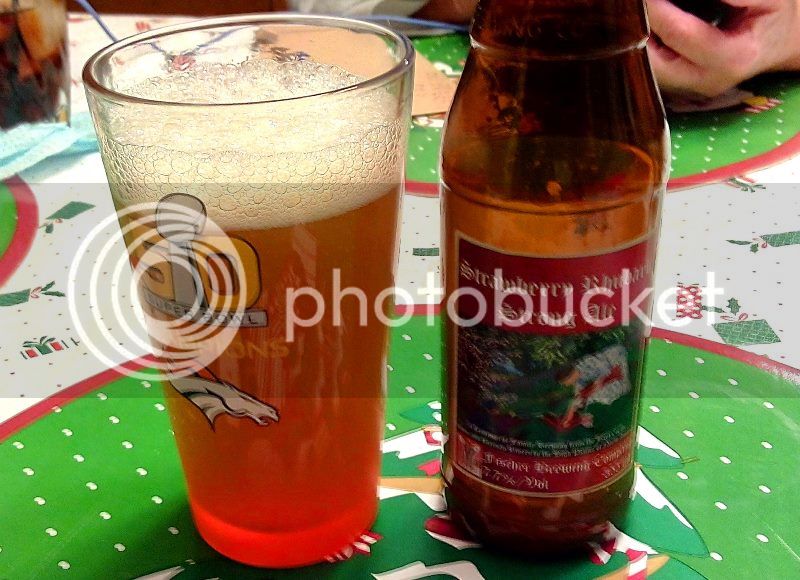TasunkaWitko
Well-Known Member
Strawberry Rhubarb Strong Ale - Recipe from Brooklyn Brew Shop - Tips and Advice
The next beer that I will be brewing is Strawberry Rhubarb Strong Ale, from Brooklyn Brew Shop’s book, MAKE SOME BEER. As with all of my "Tips and Advice" threads, this will be a running account of the experience and the things that I learn during the process.
This all-grain, 1-gallon recipe is for a strong ale that combines Belgian Pilsner and Belgian Biscuit malts, with an addition of the time-honoured team of strawberries and rhubarb to provide ambience. It is described by Brooklyn Brew Shop as “a high-alcohol taste of summer...with plumes of strawberry that fill your nose with every sip” and rhubarb “ to add balance and a little tartness.” The recipe also uses Belgian candi sugar to add to a bigger punch to the party. At 7.7% ABV, Brooklyn Brew Shop advises that you can enjoy this ale fresh, or you can “age it for a couple of extra months to mellow out the alcohol.”
This beer uses Challenger hops for bittering and Cluster hops for flavour and aroma. Both hops are described as having earthy, floral properties, with each lending its unique fruitiness to the beer, as well. In particular, I am eager to see how the cluster hops work with this beer; I’ve always had an historian’s interest in this oldest of hops grown in the US, but have never used them before and am hoping for good things.
Brooklyn Brew Shop recommends a Belgian yeast in general for this beer, and S-33 in particular, which is known for great flavours and good performance with high-alcohol beers. I am guessing that this yeast will allow the strawberries and rhubarb to shine quite well.
For those who are into stats, I plugged the recipe into Brewer’s Friend and came up with these numbers:
OG - 1.079
FG - 1.022
IBUs - 23.41 (corrected)
SRM - 5.74
All-in-all, I think that this will be a great summer beer, assuming that it is as advertised.
Here is the label that I came up with for this beer:

Since there are already a lot of strawberry-themed labels out there, I chose to put the spotlight on the rhubarb, allowing the long-familiar association with strawberries to be self-evident. This scene resonates with me very much, as I come from a long line of gardeners and gatherers and can easily imagine any one of my ancestors helping his mother pick rhubarb for pie, jam, juice, wine...or perhaps even beer. Indeed, my youngest son and I often go out and pick rhubarb, along with chokecherries, various berries, herbs, and other gifts from nature's bountiful womb.
I expect to brew this next week; however, if things go well, I might actually be able to brew it tonight. As always, I welcome any comments, suggestions or feedback on this - if anyone is interested, please feel free to chime in, or simply follow along. This recipe is in Brooklyn Brew Shop’s book (for 1 or 5 gallons), so if anyone would like to try it or learn more about it, please shoot me a PM.
More as it happens, etc. &c....
Ron
The next beer that I will be brewing is Strawberry Rhubarb Strong Ale, from Brooklyn Brew Shop’s book, MAKE SOME BEER. As with all of my "Tips and Advice" threads, this will be a running account of the experience and the things that I learn during the process.
This all-grain, 1-gallon recipe is for a strong ale that combines Belgian Pilsner and Belgian Biscuit malts, with an addition of the time-honoured team of strawberries and rhubarb to provide ambience. It is described by Brooklyn Brew Shop as “a high-alcohol taste of summer...with plumes of strawberry that fill your nose with every sip” and rhubarb “ to add balance and a little tartness.” The recipe also uses Belgian candi sugar to add to a bigger punch to the party. At 7.7% ABV, Brooklyn Brew Shop advises that you can enjoy this ale fresh, or you can “age it for a couple of extra months to mellow out the alcohol.”
This beer uses Challenger hops for bittering and Cluster hops for flavour and aroma. Both hops are described as having earthy, floral properties, with each lending its unique fruitiness to the beer, as well. In particular, I am eager to see how the cluster hops work with this beer; I’ve always had an historian’s interest in this oldest of hops grown in the US, but have never used them before and am hoping for good things.
Brooklyn Brew Shop recommends a Belgian yeast in general for this beer, and S-33 in particular, which is known for great flavours and good performance with high-alcohol beers. I am guessing that this yeast will allow the strawberries and rhubarb to shine quite well.
For those who are into stats, I plugged the recipe into Brewer’s Friend and came up with these numbers:
OG - 1.079
FG - 1.022
IBUs - 23.41 (corrected)
SRM - 5.74
All-in-all, I think that this will be a great summer beer, assuming that it is as advertised.
Here is the label that I came up with for this beer:

Since there are already a lot of strawberry-themed labels out there, I chose to put the spotlight on the rhubarb, allowing the long-familiar association with strawberries to be self-evident. This scene resonates with me very much, as I come from a long line of gardeners and gatherers and can easily imagine any one of my ancestors helping his mother pick rhubarb for pie, jam, juice, wine...or perhaps even beer. Indeed, my youngest son and I often go out and pick rhubarb, along with chokecherries, various berries, herbs, and other gifts from nature's bountiful womb.
I expect to brew this next week; however, if things go well, I might actually be able to brew it tonight. As always, I welcome any comments, suggestions or feedback on this - if anyone is interested, please feel free to chime in, or simply follow along. This recipe is in Brooklyn Brew Shop’s book (for 1 or 5 gallons), so if anyone would like to try it or learn more about it, please shoot me a PM.
More as it happens, etc. &c....
Ron




